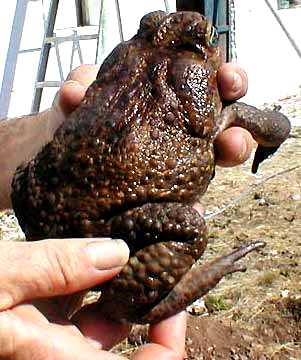An Excerpt from Jim Conrad's
Naturalist Newsletter of February 13, 2005
GIANT TOADS & FISH-FRIES
 A highlight
of many visitors' stay at Komchén is taking an early-morning jaunt up to the dock at
Telchec Puerto just northeast of here where, at incredibly low prices, some very fine fish
can be purchased directly from fishermen returning from their night's work. Then that
night back at Komchén the fish are baked over a small campfire next to the big fishpond.
As the sun sets and bats begin flitting above the pool, you hear something a bit like a
boat motor chugging along at a distance, and you see certain dark forms gathering at the
pool's edge. You are hearing and seeing Giant Toads (also called Cane Toads and Marine
Toads), BUFO MARINUS, shown at the right.
A highlight
of many visitors' stay at Komchén is taking an early-morning jaunt up to the dock at
Telchec Puerto just northeast of here where, at incredibly low prices, some very fine fish
can be purchased directly from fishermen returning from their night's work. Then that
night back at Komchén the fish are baked over a small campfire next to the big fishpond.
As the sun sets and bats begin flitting above the pool, you hear something a bit like a
boat motor chugging along at a distance, and you see certain dark forms gathering at the
pool's edge. You are hearing and seeing Giant Toads (also called Cane Toads and Marine
Toads), BUFO MARINUS, shown at the right.
Giant Toads look just like average American toads except that, by comparison, they
are... gigantic. They grow up to 9 inches long from snout to rear end, and can weigh more
than two pounds. When you catch one, sometimes it keeps calling. Its big belly is
flabby-fat and pulsates as the toad calls, so holding such a toad is an experience unlike
holding any other kind of creature. You can't keep from laughing.
The toad does not just passively rejoice in being held, however. If it thinks it's in
danger, you'll find your hands smeared with a milky substance issuing from the parotoid
glands behind its head. This milky stuff, called bufotoxin, is toxic enough to burn the
eyes, inflame skin if it's not washed off, and a good dose of it can kill a dog or a cat.
I asked my Maya-speaking friend Don Elías if he'd heard of dogs getting sick after
attacking Giant Toads. He said he'd never heard of any problem at all with them, but that
he's seen dogs die after chomping down on another toad species we have here, about the
same size as our US toads. Well, all the toads I know of produce bufotoxin to some degree
or another, and it sounds like Mexican dogs have more sense than to bite a Giant Toad, but
not enough sence to not bite a little toad.
Giant Toads are native from Mexico to South America's Amazon region, but they've been
introduced into southern Florida, the Caribbean, Australia and other places. A lot of
people now wish they'd never seen them. The main problem with them is that they are so
omnivorous and they eat so much that they tend to either out-compete or simply eat many
other forms of life. Wherever they go, species diversity generally diminishes. If you're
only concerned about your garden you may be happy to have Giant Toads eating your bugs but
if you're concerned about broader ecosystem stability, Giant Toads make you worry a lot.
Still, on a warm evening sitting next to the fishpond as dusk comes on, it's very
pleasant hearing the Giant Toads motor-boating all along the bank.
 A highlight
of many visitors' stay at Komchén is taking an early-morning jaunt up to the dock at
Telchec Puerto just northeast of here where, at incredibly low prices, some very fine fish
can be purchased directly from fishermen returning from their night's work. Then that
night back at Komchén the fish are baked over a small campfire next to the big fishpond.
As the sun sets and bats begin flitting above the pool, you hear something a bit like a
boat motor chugging along at a distance, and you see certain dark forms gathering at the
pool's edge. You are hearing and seeing Giant Toads (also called Cane Toads and Marine
Toads), BUFO MARINUS, shown at the right.
A highlight
of many visitors' stay at Komchén is taking an early-morning jaunt up to the dock at
Telchec Puerto just northeast of here where, at incredibly low prices, some very fine fish
can be purchased directly from fishermen returning from their night's work. Then that
night back at Komchén the fish are baked over a small campfire next to the big fishpond.
As the sun sets and bats begin flitting above the pool, you hear something a bit like a
boat motor chugging along at a distance, and you see certain dark forms gathering at the
pool's edge. You are hearing and seeing Giant Toads (also called Cane Toads and Marine
Toads), BUFO MARINUS, shown at the right.